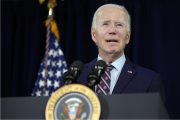
A reporter for Newsweek’s online publication, The Daily Beast, described the goings-on in and around the battle in Zumar in northern Iraq on Monday, noting in particular “multiple armored Toyotas sweeping down the mountain” and passing within a few feet of the reporter’s position. “The Toyotas were packed with what appeared to be bearded Western Special Operations Forces. I watched the trucks pass and saw for myself the crews inside them. They didn’t wear any identifying insignia but they were visibly Western and appeared to match all the visual characteristics of American special operations soldiers.”
The Daily Beast, perhaps out of concern for the reporter’s safety, gave no byline to the article and did not identify its author. A British publication, referring to the Daily Beast story, said it was written by a young journalist with some impressive credentials. “This particular journalist should know,” the Daily Mail observed. “He’s a 27-year-old former U.S. Army Ranger who served three tours in Iraq and two in Afghanistan.”
The report did not rest entirely on the journalist’s first-hand observation, however. “Ranking members of the Kurdish military and intelligence service said that one team of U.S. Special Operations was on the ground in Zumar along with several German counterparts, working in conjunction with [Kurdish] Peshmerga units,” the dispatch said. “According to the Kurdish sources, U.S. and German special operations teams had taken up positions in Zumar that allowed them to coordinate with U.S. aircraft.” The Daily Beast’s effort to get confirmation from the Pentagon was not nearly as successful.
“There are no U.S. troops on the ground in or around Zumar,” was the official response, with a spokesman for U.S. Central Command, saying U.S. involvement in the fighting Monday consisted only of “one strike destroying several vehicles in the vicinity of Zumar.” That implicitly presented the journalist and his Kurdish sources with the question posed by Chico Marx in Duck Soup. “Well, who you gonna believe, me or your own eyes?”
As the Islamic State continues its warring in Iraq and yet another American journalist has been the subject of a jihadist beheading, there are signs of strain in the bipartisan consensus against putting “boots on the ground” again in Iraq. President Obama has pledged he would not send combat units into Iraq, where U.S. forces fought for more than a decade, but the “special ops” guys are not considered combat forces. They’re what might be called the Triple A team — Armed, Aggressive Advisors. Both Secretary of State John Kerry and his frequent critic Arizona Senator John McCain have said air strikes alone will not defeat the self-proclaimed Islamic State of Iran and Syria (ISIS), but neither has suggested a need for U.S. combat troops. McCain and fellow Republican Senator Lindsey Graham of South Carolina authored an op-ed piece that appeared in last Saturday’s New York Times that called for U.S. advisors working with Iraqi government forces and regional allies to thwart the Islamic State offensive.
We should embed additional United States special forces and advisers with our partners on the ground – not to engage in combat, but to help our partners fight ISIS and direct airstrikes against it. Regional allies should play a key role in this effort. No one is advocating unilateral invasion, occupation or nation-building. This should be more like Afghanistan in 2001, where limited numbers of advisers helped local forces, with airstrikes and military aid, to rout an extremist army.
That, of course, leaves out what Paul Harvey used to call “the rest of the story.” That limited role in Afghanistan in 2001 turned into a much larger and more lasting involvement, with U.S. troop levels of more than 160,000 before the current drawdown of forces toward a scheduled exit of combat units by the end of this year — 13 years after a “limited number of advisers” came into help local forces. President Obama’s decision this week to send another 350 troops to Iraq will bring the total number of Americans there to about 1,100. Americans. It seems to be forgotten that our nation’s cemeteries and veterans hospitals remain home to the dead and wounded of a war that began long ago with a few hundred, then several thousand advisors, followed by more than half a million combat troops — in a place called Vietnam.
There are a lot of echoes from past wars in the recommendations we are hearing now. Retired Marine Corps General Anthony Zinni, former head of U.S. Central Command, was on Meet the Press last Sunday, lamenting that the nation’s leaders had become “so paranoid about boots on the ground.” The general expressed a robust optimism about the task of driving the jihadists out of Iraq.
“Very simply put, if you put two brigades on the ground of U.S. forces, they would push ISIS back to Syria in a heartbeat and probably take less time, less cost, and I think in the long run fewer casualties overall.” It was little more than a dozen years ago that Kenneth Adelman, a prominent expert on military affairs expressed a similar optimism with a famous metaphor to illustrate what liberating Iraq would be like.
“Cakewalk,” anyone?


